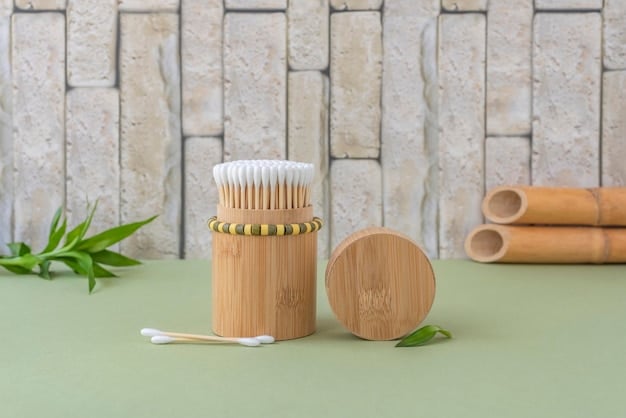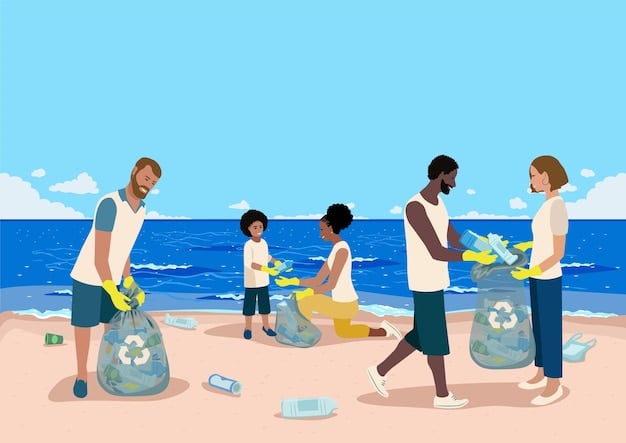Plastic-Free Living: Reduce Your Plastic Consumption by 75% in 3 Months

Achieving significant plastic reduction is attainable through conscious choices and simple swaps. This guide demonstrates how to reduce your plastic consumption by 75% within three months by adopting practical, sustainable alternatives in daily routines, from shopping habits to personal care, fostering a more eco-friendly lifestyle.
Embarking on a journey towards plastic-free living: simple swaps to reduce your plastic consumption by 75% in 3 months might seem daunting, yet it’s an incredibly achievable goal with profound environmental benefits. This guide will walk you through practical, actionable steps to drastically cut down on plastic, transforming your habits and contributing to a healthier planet. Within just three months, you can witness a remarkable reduction in your plastic footprint.
Understanding the plastic problem and its urgent solutions
Plastic pollution has emerged as one of the most pressing environmental crises of our time, impacting ecosystems, wildlife, and human health. Our reliance on single-use plastics has created an overwhelming volume of waste that often ends up in landfills or, worse, pollutes our oceans and natural landscapes. This pervasive issue demands immediate and effective solutions, and reducing personal plastic consumption is a powerful starting point.
The urgency stems from the long decomposition rates of plastic—hundreds to thousands of years—and its breakdown into microplastics that infiltrate everything from our food chain to the air we breathe. Addressing this crisis requires a multi-faceted approach, combining policy changes, corporate responsibility, and individual actions. While systemic change is essential, consumer demand for sustainable alternatives can significantly drive market shifts. By consciously opting for plastic-free products, we send a clear message to manufacturers and retailers about our environmental priorities, encouraging them to innovate and adopt more sustainable practices. Moreover, understanding the lifecycle of plastics, from production to disposal, illuminates the comprehensive nature of the problem, allowing us to make more informed decisions about consumption.
The global impact of plastic waste
- Ocean pollution: Millions of tons of plastic enter our oceans annually, harming marine life and disrupting delicate ecosystems.
- Microplastic contamination: Tiny plastic particles are now ubiquitous, found in water, soil, air, food, and even human bodies, raising significant health concerns.
- Resource depletion: Plastic production relies heavily on fossil fuels, contributing to climate change and depleting finite resources.
- Landfill burden: Landfills are overflowing with plastic waste, occupying vast amounts of land and often releasing harmful chemicals into the environment.
Moving towards a plastic-free lifestyle is not merely a trend but a necessary evolution in our relationship with consumer goods. It requires a shift in mindset, from convenience-driven choices to environmentally conscious decisions. This transformation begins with awareness and progresses through consistent effort, demonstrating that small, everyday changes can collectively lead to substantial positive impacts on the planet. By embracing this challenge, we become part of a larger movement dedicated to fostering a healthier, more sustainable future for all.
This commitment extends beyond just avoiding single-use items; it also involves rethinking our purchasing habits, embracing durability, and supporting businesses that prioritize sustainability. The journey toward significant plastic reduction is an ongoing process of learning and adapting, but the rewards—a cleaner environment and a more mindful way of living—are immeasurable.
Month 1: Tackling kitchen and grocery plastics
The kitchen and grocery shopping are often the biggest sources of plastic waste in our homes. By focusing on these areas during your first month, you can achieve a substantial reduction in your plastic consumption. This phase primarily involves making conscious choices at the supermarket and investing in a few key reusable items that will serve you well in the long run.
To begin, conduct a “plastic audit” of your kitchen. Look at your pantry, refrigerator, and cleaning supplies. Identify items that come in unnecessary plastic packaging, single-use bags, or plastic containers. This initial assessment will highlight your biggest plastic pain points and help you prioritize your swaps. Once you have a clear picture, you can start implementing changes methodically, one area at a time, making the transition less overwhelming.
Grocery shopping essentials and smart choices
- Reusable bags: Always carry canvas or cloth bags for groceries, produce, and bulk items.
- Bulk buying: Purchase grains, nuts, seeds, pasta, and dried fruits from bulk bins using your own reusable containers or cloth bags. Many stores now offer extensive bulk selections.
- Refill stations: Look for stores with liquid refill stations for olive oil, vinegar, honey, and even cleaning supplies.
- Produce bags: Opt for reusable mesh or cloth produce bags instead of the thin plastic bags provided in stores.
- Glass or stainless steel containers: Store leftovers and lunch in glass or stainless steel containers instead of plastic ones. They are durable, non-toxic, and long-lasting.
When shopping, prioritize fresh, unpackaged fruits and vegetables. Choose items from the deli that can be wrapped in paper or your own reusable container, if the store policy allows. Avoid heavily processed foods, which often come in multiple layers of plastic. Remember that every small decision accumulates over time, making a significant difference in your overall plastic footprint. Start to read labels not only for ingredients but also for packaging materials.
Consider making some items from scratch. For instance, homemade bread, yogurt, or even snacks can eliminate a lot of pre-packaged plastic. This not only reduces waste but often results in healthier, fresher food. Preparing your own meals from whole ingredients empowers you to control your consumption habits and reduces reliance on convenience foods that are typically wrapped in plastic. This proactive approach to food preparation fosters a more sustainable and cost-effective lifestyle.
Month 2: Personal care, cleaning, and on-the-go habits
Having established new habits in your kitchen, the second month shifts focus to personal care routines, household cleaning, and changing your on-the-go consumption patterns. These areas might seem less obvious for plastic reduction but often hide a surprising amount of single-use plastic. This phase involves a bit more research and experimentation to find the right plastic-free alternatives that fit your lifestyle and preferences.
Start by examining your bathroom cabinet and cleaning supplies. Note all the plastic bottles, tubes, and containers. Then, consider your daily routine when you leave the house—what single-use plastic items do you encounter or use? Identifying these “hidden” plastic sources will help you systematically replace them with more sustainable options. This month is about broadening your awareness of plastic beyond just food packaging and integrating plastic-free choices into more aspects of your daily life. It’s also an opportunity to discover innovative and often more natural products.

Eco-friendly personal care swaps
- Shampoo and conditioner bars: Replace bottled liquid products with solid bars, which typically come in paper packaging or no packaging at all.
- Bamboo toothbrushes: A simple swap for plastic toothbrushes, bamboo is compostable and a much better alternative.
- Safety razors: Switch from disposable plastic razors to a reusable safety razor with recyclable metal blades. This is a significant long-term money saver too.
- Refillable skincare and soap: Look for brands offering refillable options for lotions, hand soaps, and body washes, or consider making your own.
- Deodorant in eco-friendly packaging: Many brands now offer deodorants in compostable cardboard tubes or glass jars.
When it comes to cleaning, consider making your own cleaning solutions using ingredients like vinegar, baking soda, and essential oils. This not only reduces plastic waste from cleaning product bottles but also avoids harsh chemicals. For items you can’t make yourself, look for concentrated tablets or powders that come in minimal or compostable packaging, like dishwasher detergent pods in dissolvable wraps. Moreover, microfibre cloths can replace disposable paper towels, reducing both plastic and paper waste. Embracing these changes transforms your home into a more environmentally conscious space.
Sustainable on-the-go solutions
- Reusable water bottle: Carry a stainless steel or glass water bottle with you everywhere to avoid buying bottled water.
- Travel mug: Bring your own reusable coffee cup to cafes for hot beverages. Many cafes offer discounts for this.
- Reusable cutlery and straws: Keep a set of bamboo or metal cutlery and a reusable straw in your bag for meals out.
- Snack boxes: Pack your own snacks in reusable containers to avoid single-serving plastic wrappers.
- Shopping bags (again): Always have a compact reusable bag ready for impromptu purchases, even small ones.
These on-the-go habits are critical because they address the pervasive single-use culture. By being prepared, you proactively eliminate the need for disposable plastics in everyday situations, from your morning coffee to an unexpected meal. This month emphasizes foresight and planning, illustrating that convenience does not have to come at the expense of the environment. Each small, consistent choice builds towards the significant 75% reduction goal within your three-month timeline.
Month 3: Advanced swaps and lifestyle integration
By the third month, you’ve developed a strong foundation in plastic-free living, having tackled major sources of waste in your kitchen, personal care, and on-the-go habits. This final month focuses on refining your approach, addressing less obvious plastic sources, and fully integrating plastic-free principles into your broader lifestyle. It’s about moving beyond immediate swaps to a more holistic, low-waste mindset, making these choices second nature. This stage involves a deeper commitment to questioning consumption patterns and seeking innovative solutions for everyday challenges.
During this period, you might explore areas like clothing (microplastics from synthetic fabrics), pet supplies, garden products, and even gifts. The goal is to identify lingering plastic problem areas and find sustainable alternatives. This phase is less about quick fixes and more about long-term commitment and creative problem-solving. It’s about empowering yourself to be a mindful consumer in all aspects of your life, extending your positive impact far beyond the initial practical swaps, and fostering a truly integrated eco-conscious existence.
Digging deeper: less common plastic culprits
- Clothing: Favor natural fibers like cotton, linen, hemp, and wool over synthetics (polyester, nylon, acrylic) which shed microplastics when washed.
- Pet supplies: Look for pet food in paper or recyclable metal containers, and choose biodegradable pet waste bags or natural fiber toys.
- Gardening: Opt for wooden or metal tools, terracotta pots, and natural pest control methods over plastic garden tools and chemical sprays in plastic bottles.
- Office supplies: Choose pens made from recycled materials or wood, and staplers/binders made from metal or bamboo.
- Children’s toys: Prioritize toys made from wood, silicone, rubber, or metal over plastic ones, which often break quickly and are difficult to recycle.
Consider the broader implications of your purchases, not just the product itself, but its packaging, transportation, and end-of-life disposal. This involves supporting businesses that align with your values and actively seeking out refillable, reusable, and recyclable options whenever possible. The shift from single-use to multi-use items becomes a core principle guiding your consumption, not just for plastic but across all materials. For example, instead of cling film, consider beeswax wraps or silicone lids.
Another key aspect of this month is community engagement. Share your insights and experiences with friends and family, encouraging them to consider their own plastic reduction journeys. Participating in local clean-up events or supporting advocacy groups can amplify your impact. Your personal actions, combined with collective efforts, send a powerful message about the urgent need for a plastic-free future. This community aspect reinforces your commitment and helps build a supportive network. Embracing a plastic-free lifestyle is a continuous learning process, with each step contributing to a more sustainable world for future generations.

Beyond the three months: Maintaining momentum and advocating for change
Achieving a 75% reduction in plastic consumption within three months is a commendable feat, but the journey towards a truly plastic-free life is ongoing. This phase is about solidifying your new habits, staying informed, and becoming an advocate for broader systemic change. It’s no longer just about personal swaps but about influencing your community and consumer landscape to embrace more sustainable practices. Maintaining momentum means continuously seeking improvements, adapting to new challenges, and inspiring others to join the movement.
Staying informed about new sustainable products, recycling innovations, and environmental policies will empower you to make even better choices. It also allows you to identify areas where your efforts can have the greatest impact. Furthermore, resisting the temptation of convenience single-use items in moments of haste or fatigue requires conscious effort and a solidified commitment to your environmental values. This long-term thinking ensures that your initial three-month effort translates into lasting, impactful change, fostering a truly sustainable existence beyond the initial challenge.
Sustaining your plastic-free journey
- Regular audits: Periodically review your consumption habits to identify new areas for reduction or forgotten plastic items.
- Mindful consumption: Before buying, ask yourself: Do I really need this? Can I borrow it? Can I find it secondhand? Can I make it? Is it plastic-free?
- Repair and reuse: Extend the life of your items by repairing them instead of replacing them. Upcycle items when possible.
- DIY solutions: Continue exploring making your own products, from cleaning supplies to beauty items, to reduce reliance on packaged goods.
- Support ethical brands: Prioritize businesses with strong environmental commitments and transparent supply chains.
Advocacy plays a crucial role in expanding the impact of your personal efforts. Engage with businesses to request plastic-free options, write to your local representatives about plastic reduction policies, and participate in community discussions about waste management. Your voice, combined with others, can push for systemic changes that go beyond individual consumer choices, influencing legislation and corporate practices. Sharing your plastic-free journey on social media or with friends can also inspire others and build a supportive network of like-minded individuals. This collective action is vital for accelerating the transition to a global plastic-free economy.
Remember that perfection is not the goal; continuous improvement and conscious effort are. There will be times when plastic is unavoidable, but every deliberate choice against it makes a difference. By maintaining your commitment and advocating for change, you contribute to a more sustainable future and inspire others to embark on their own plastic-reducing journeys, ensuring that the movement continues to grow and flourish for years to come.
Addressing common challenges and misconceptions
The transition to plastic-free living, while immensely rewarding, can come with its fair share of challenges and common misconceptions. It’s essential to address these head-on to ensure a smoother, more realistic journey. Many people might feel overwhelmed by the perceived difficulty, cost, or inconvenience of adopting a plastic-free lifestyle, leading to assumptions that can hinder their progress. Understanding and dispelling these myths is crucial for maintaining motivation and making sustainable choices accessible to everyone.
One prevalent misconception is that going plastic-free is inherently expensive. While some initial investments in reusable items might seem higher upfront, they often lead to significant long-term savings by reducing recurring purchases of disposable items. Another challenge is the lack of readily available plastic-free options in certain areas or for specific products. This requires a shift towards more thoughtful shopping, perhaps exploring online eco-stores or dedicated bulk retailers, or even making some items yourself. Acknowledging these hurdles allows for proactive solutions and a more adaptable approach to sustainable living.
Overcoming obstacles and embracing flexibility
- “It’s too expensive”: Focus on long-term savings from reusables (e.g., safety razor vs. disposable cartridges, solid shampoo bars vs. bottled products). Many DIY solutions are also very cost-effective.
- “It’s inconvenient”: Preparation is key. Keep reusable bags, bottles, and cutlery handy. Make these items part of your daily routine so they are always available.
- “Not all options are available”: Start with what you can change. Every swap counts. Research online stores or local eco-shops if certain items are hard to find.
- “Perfect is the enemy of good”: Don’t aim for 100% perfection immediately. Celebrate small victories and focus on continuous improvement. Progress, not perfection, is the goal.
- “My impact is too small”: Collective individual actions create massive change. Your choices influence others and send demand signals to industries.
Dispelling the myth that a plastic-free lifestyle is an all-or-nothing endeavor is vital. Incremental changes are powerful, and even small steps contribute significantly to the broader environmental movement. It’s also important to recognize that while plastic-free is the ideal, sometimes plastic is unavoidable. The focus should be on *reducing* reliance on single-use plastics and seeking more sustainable alternatives whenever possible, rather than striving for an unattainable absolute. This flexible and pragmatic approach ensures that the journey is sustainable for you as an individual, preventing burnout and promoting long-term commitment.
Another challenge can be navigating social situations where plastic might be prevalent. Politely declining single-use items or offering your reusable alternatives can make a statement without being preachy. Educating friends and family by example, rather than judgment, tends to be far more effective in inspiring change. Ultimately, addressing these challenges with patience, persistence, and a focus on progress allows you to overcome perceived barriers and continue making a meaningful impact towards a less plastic-dependent world.
The ripple effect: inspiring others and community impact
Your personal journey to reduce plastic consumption doesn’t end with your own habits; it creates a powerful ripple effect that can inspire friends, family, and your broader community. By demonstrating the feasibility and benefits of plastic-free living, you become a catalyst for change, turning abstract environmental concerns into tangible, achievable actions. This goes beyond mere advice-giving; it’s about leading by example and showing others that a sustainable lifestyle is not only possible but also enriching. Your actions become a living testament to environmental stewardship.
When others witness your conscious choices—whether it’s carrying your reusable coffee cup, using bulk bins, or opting for unpackaged produce—they often become curious and motivated to explore similar paths. This organic spread of sustainable practices is incredibly powerful, as it fosters a collective shift in consumer behavior and societal expectations. Education through action is often the most effective way to encourage deeper engagement with environmental issues, allowing others to see how small daily changes can accumulate into significant positive impacts on the environment.
Building a plastic-free community
- Share your journey: Talk openly but humbly about your plastic-free swaps and the benefits you’ve experienced. Share tips and resources.
- Host workshops: Organize a small gathering to share practical skills, like making beeswax wraps or homemade cleaning solutions.
- Support local: Patronize businesses that offer plastic-free options or bulk purchasing, signaling consumer demand for sustainable practices.
- Engage on social media: Use your platform to highlight plastic-free products, share success stories, and raise awareness about environmental issues.
- Participate in clean-ups: Join local beach or park clean-up events to visibly contribute to reducing existing plastic pollution and inspire others.
Beyond individual-to-individual influence, your actions contribute to a larger communal demand for systemic change. As more people adopt plastic-free habits, businesses and policymakers respond with more sustainable product offerings and regulations. This creates a positive feedback loop: individual action drives market innovation, which in turn makes plastic-free living even more accessible for everyone. Your commitment, no matter how small it feels, is a vital part of this larger movement towards a regenerative economy.
Consider the cumulative impact of even a small group of individuals committed to reducing their plastic footprint. When these micro-changes are scaled up across cities, states, and nations, the potential for environmental regeneration is immense. Every plastic bottle avoided, every bulk purchase made, and every conversation sparked contributes to a growing wave of environmental consciousness. Ultimately, inspiring others fosters a more resilient and responsible society, collectively moving towards a future where plastic pollution is a problem of the past, proving that individual dedication can truly catalyze widespread, positive change.
Measuring your success and continuous improvement
Reaching the three-month mark with a 75% reduction in plastic consumption is a significant achievement, but the journey toward a zero-waste lifestyle is one of continuous improvement. Measuring your success isn’t just about counting plastic items; it’s about recognizing the changes in your habits, your mindset, and your environmental impact. This ongoing assessment allows you to fine-tune your approach, identify new areas for reduction, and acknowledge the positive shifts you’ve made. It also helps reinforce your commitment and celebrate progress.
Start by revisiting your initial “plastic audit” and comparing your current daily consumption to your baseline. You might be surprised at how much less plastic you encounter in your trash bin or recycling. Beyond the quantitative aspects, reflect on the qualitative changes: do you feel more connected to your consumption habits? Are you more mindful of your environmental footprint? This holistic view of success motivates further dedication. Continuous improvement means seeking out innovative plastic-free solutions as they emerge and adapting to new challenges, ensuring your commitment remains dynamic and effective in the long term.
Strategies for ongoing impact measurement
- Visual waste audit: Periodically empty your trash and recycling bins to visually assess remaining plastic. This can be very insightful.
- Track your swaps: Keep a running list of plastic items you’ve successfully replaced and note any new ones you encounter.
- Carbon footprint calculators: While not exclusively plastic-focused, some tools include plastic consumption in broader environmental impact assessments.
- Reflect on purchasing habits: Are you instinctively opting for plastic-free choices? Is it becoming second nature?
- Share and learn: Engage with online communities or local groups to share experiences and learn new tips for further reduction.
The lessons learned over these three months extend far beyond plastic. You’ve likely developed a greater appreciation for sustainable living, the power of conscious consumerism, and the critical role individuals play in environmental protection. This shift in perspective is perhaps the most valuable outcome, shaping your future decisions in a way that benefits both yourself and the planet. By embracing this continuous journey of learning and adaptation, you ensure that your dedication to plastic-free living remains robust and impactful. This ongoing commitment transforms a temporary challenge into a lifestyle, inspiring a broader movement for sustainable change. It’s about building a cleaner, healthier future, one conscious choice at a time, and never ceasing to seek out more impactful ways to contribute to environmental resilience.
| Key Area | Core Action |
|---|---|
| 🛒 Grocery & Kitchen | Prioritize bulk, unpackaged items, and reusable bags/containers. Opt for homemade where possible. |
| 🧼 Personal Care & Cleaning | Switch to solid bars, safety razors, and DIY cleaning solutions. Utilize refill stations. |
| 🚶♀️ On-the-Go Habits | Always carry reusable bottles, coffee cups, and cutlery to avoid disposables. |
| 🌿 Lifestyle Integration | Choose natural fibers, support ethical brands, and advocate for broader change. |
Frequently Asked Questions about Plastic-Free Living
▼
Yes, achieving a 75% reduction is highly feasible with conscious effort and strategic swaps. Focusing on high-impact areas like groceries, personal care, and on-the-go habits can quickly yield significant results. It requires commitment and planning, but many modern alternatives make the transition smoother than ever, contributing substantially to a lower plastic footprint.
▼
Some of the most challenging items to replace include certain food packaging (like meat trays or cling film), medications, and specific electronics components. These often lack readily available plastic-free alternatives. However, continuous innovation is addressing these gaps, and focusing on the larger, more common plastic items is where you’ll see the most immediate impact on reduction.
▼
Absolutely. While some initial investments in reusable items might be required, plastic-free living often leads to significant long-term savings. For instance, solid shampoo bars last longer than bottled counterparts, safety razors eliminate costly disposable cartridges, and buying in bulk reduces unit prices. Making homemade versions of common products also cuts down on expenses, making it an economically smart choice.
▼
Leading by example is often the most effective method. Start with simple, visible changes like using reusable bags or finding tasty unpackaged snacks. Share your reasoning and the benefits (e.g., cost savings, better health) without being judgmental. Make it easy for them by stocking plastic-free options and engaging them in positive conversations about the impact of everyday choices, fostering a collaborative approach.
▼
In cases where a plastic-free alternative isn’t available, focus on reducing usage, reusing what you have, or choosing options with the most easily recyclable plastic. Remember, the goal is significant reduction, not absolute elimination, which is often impracticable in the current consumer landscape. Even small steps, like finding products in fewer layers of plastic, contribute positively to the overall objective.
Conclusion
Achieving a 75% reduction in plastic consumption within three months is not just an ambitious goal but a profoundly tangible one, transforming daily habits into powerful acts of environmental stewardship. This journey, from decluttering your kitchen of single-use items to embracing mindful choices on the go, underscores the profound impact individual actions can have. Beyond the quantitative reduction, it cultivates a deeper appreciation for sustainable living, encouraging inventive solutions and fostering a more conscious relationship with consumption. Your commitment to plastic-free living transcends personal benefit, extending a vital ripple effect that inspires communities and compels industries toward a greener, less plastic-dependent future.





